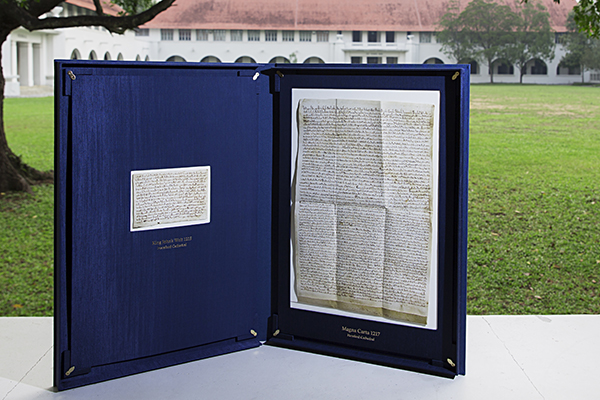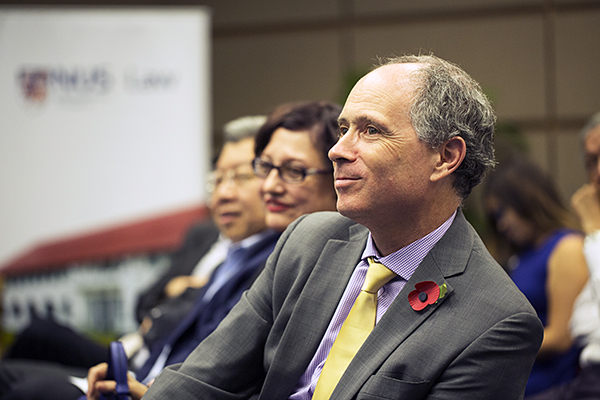Media - News
- Media
- Magna Carta visits NUS
Magna Carta visits NUS

NUS Law spoke to Adjunct Professor Kevin Tan who curated the exhibition around the visit of the Magna Carta to Singapore in November 2015. The Hereford Cathedral replicas were brought to the NUS Bukit Timah campus courtesy of the British High Commission. NUS Law hosted the replicas and held a panel discussion chaired by Justice Judith Prakash to peel away the myths, mantras and misconceptions behind the Magna Carta revealing an instrument that was not born to greatness but instead had greatness thrust upon it.
What is the Magna Carta?
The Magna Carta was not one document but a series of documents, the first of which was sealed by King John I on 12 June 1215 at Runnymede. I often refer to the Magna Carta as a ‘deed of desperation’ on the part of John because it was his attempt to save his own skin from the rebelling barons and prevent a full-scale civil war from breaking out. The document itself is a rather haphazard litany of 63 demands the barons made of John. These included protection clauses for the Church and limited the King’s prerogative of taxation.
Significantly it placed the law about the King, and two key clauses in the Charter continue to resonate today – Clauses 39 and 40. The first states that no person shall be seized or imprisoned or stripped of his rights or possessions or outlawed or exiled ‘except by the judgment of his equals or by the law of the land’ and the other, that ‘To no one will we sell, to no one deny or delay right or justice’. These two clauses have found their way into most of the world’s constitutions and human rights documents in one form or another.
The Magna Carta was reissued and reaffirmed several times – in 1216, 1217, 1225 and finally in 1239 – and it was only in 1225 that it became known as the Magna Carta or Great Charter of Liberties, to distinguish it from the Forest Charter of the same year.
How is it significant to Singapore?
For a time it was part of Singapore law. After 1297, the Magna Carta was included in the English Roll of Statutes and this was imported wholesale into Singapore through the Second Charter of Justice of 1826. Of course, most of these old English statutes no longer apply, especially with the passage of the Application of English Law Act in 1993. In any case, most of its clauses are obsolete. However, it is the spirit of the two key clauses in the Magna Carta that continue to be relevant. They are enshrined in Articles 9 and 12 of the Constitution, albeit in a different form.
How did you come to curate this exhibition in Singapore?
I was approached by the British High Commission, who had been looking around for a legal historian to curate the Singapore leg of the exhibition. My old friend Kwa Chong Guan, who was formerly Director of the National Museum and now Chairman of the National Archives of Singapore suggested that they contact me since there are very few scholars in Singapore who work on legal history. Of course, as a legal historian and scholar of constitutional law, this was an opportunity not to be missed.
What has gone into bringing the Magna Carta to Singapore?
The British Foreign and Commonwealth Office, working with Hereford Cathedral, put together some funds to take Hereford’s 1217 version of the Magna Carta on tour through 7 countries, including Singapore. This is quite rare since the Magna Carta hardly ever goes on tour. The last tour was by the Lincoln Cathedral’s 1215 copy which went to America in 1939. There are only four surviving copies of the 1215 version and four surviving copies of the 1217 version. Even more spectacular and rare than the touring Magna Carta is Hereford’s ‘Letter of King John’ from 1215. This is the sole surviving copy of the letters which were sent by the King to the Sheriffs, ordering them to obey the Charter and make it known to the people. That’s a real treat.
What were some of the events organised to celebrate the Magna Carta in Singapore?
A five-day exhibition of the Hereford Magna Carta will be staged at the Supreme Court from 19 to 24 November. In conjunction with the display, there is a small exhibition (which I curate) telling visitors about the history of the Magna Carta, what it says, and its continuing influence and significance, as well a bit about Hereford Cathedral and its treasures. Three talks were staged as a prelude to the Exhibition. The first was at NUS Law Faculty on 9 November.




